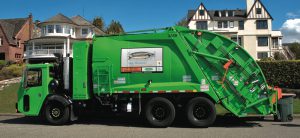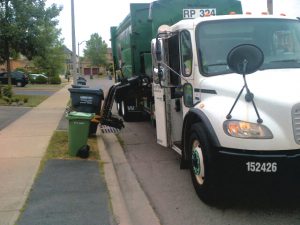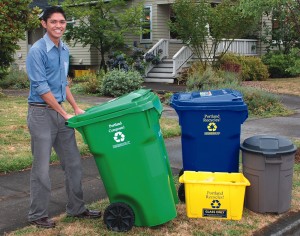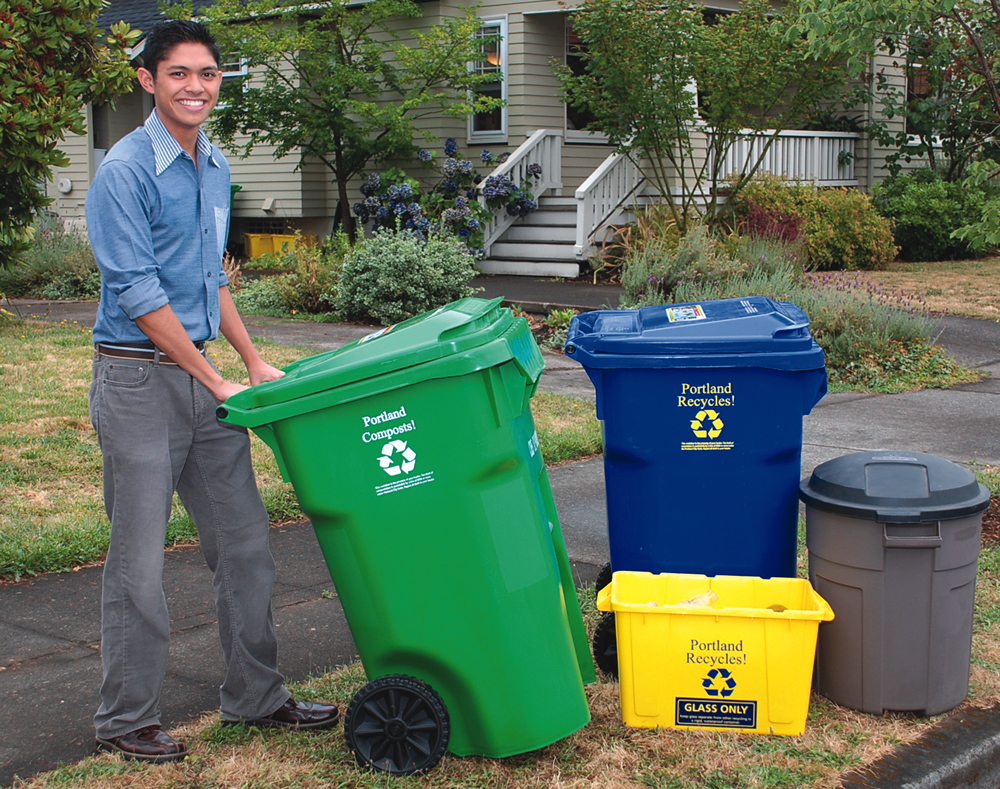Biweekly garbage collection is being implemented to increase recycling and either introduce or enhance the diversion of source separated organic wastes.
Peter Gorrie
BioCycle August 2012, Vol. 53, No. 8, p. 25

Seattle Public Utilities began a biweekly garbage collection pilot in July, primarily to evaluate cost savings for its overall solid waste program.
When Port Coquitlam, a community of 58,000 near Vancouver, British Columbia, began biweekly garbage collection from its 12,500 single-family homes three years ago, comments from critics “were pretty nasty, like nothing I’d seen before,” says Mayor Greg Moore. That sort of response makes local councils reluctant to step into the issue and, when they do, they tread as cautiously as anyone trying to avoid soiling shoes while crossing a cattle pasture.
Yet, in most places where it has been tried — usually accompanied by enhanced recycling and organics programs — it has worked well and won widespread acceptance. Last fall, when Port Coquitlam held its first elections since the change, every candidate who pledged to restore weekly garbage service was defeated, says Moore, who also chairs the board of directors of Metro Vancouver, the regional government for the city and 21 suburban municipalities. Most residents now argue, “it’s working. Why would you want to do that?” The communities in Metro Vancouver have agreed to have waste management plans in place by the end of this year and to implement biweekly garbage collection by 2015.
In Portland, Oregon, which last November became the first large American municipality to launch biweekly trash collection, a few residents are protesting by putting trash into their organics bins, says Arianne Sperry of the city’s Bureau of Planning and Sustainability. “The majority are making it work. It does take some effort — and time to make the transition. Some people are still struggling … but a lot are feeling it’s working for them.”
Everywhere, much of the opposition stems from simple resistance to innovation. “When someone has been doing something for so long, when you’ve been taking your garbage to the curb every week, and then you start to bring in change, it’s hard for people to accommodate that,” Moore says. But he and others who administer solid waste management programs also point to what they consider is a pervasive misunderstanding of the new programs that overstates its problems and ignores significant benefits.
In most cases, biweekly garbage collection has been implemented as part of a plan to increase diversion of organics and recyclables. Organics are picked up every week in almost all the programs in place or proposed. Some also collect recyclable materials every week; others alternate it with the garbage service. Therefore food scraps and other compostable wastes are picked up as often as they had been with weekly garbage collection. Most of what’s left in the trash, officials say, won’t decompose, smell or attract pests. The “yuck factor” shouldn’t be a concern.
There are, however, two major qualifications to this rosy view: First, most organics programs process these wastes in windrow composting facilities that aren’t allowed by their operating certificates to accept diapers, incontinence products and pet wastes. Thus, residents can’t put these “yucky” materials into their green bins and, instead, must retain them for up to two weeks until they’re picked up in the garbage collection.
Second, most programs reject green bin contents if they’re sealed in the conventional plastic bags people usually use for their trash. Not all communities allow residents to substitute compostable bags. So, rather than just dumping their food scraps into a leak-proof bag, tying it securely when it’s full and tossing it into a trash can, it is suggested that residents line their bins with paper, and clean the containers frequently.
Such requirements, added to resistance to change, make biweekly garbage collection still “pretty rare,” says Lori Scozzafava, deputy executive-director of the Maryland-based Solid Waste Association of North America (SWANA). Without a national database, she can’t cite statistics, but “certain communities are looking at it, especially since money is tight. I wouldn’t be surprised if more are looking at it, but I haven’t heard of a groundswell.”
Those involved say the shift to biweekly pick-up requires extensive communication and strong political support. “When things change, it’s interesting to see how important garbage collection is to folks,” Scozzafava adds. “But if it’s implemented well, it seems to be fine. With proper information, people adapt and it becomes what is.”
Adoption In Canada

The Region of Peel, Ontario is in the midst of a year-long alternate week trash collection pilot with 6,000 single-family homes. The impact on increased use of the existing Green Bin (organics) and Blue Box (recycling) containers and overall program costs are being evaluated.
The move to biweekly collection was recommended by a community consultation group, which helped it to gain acceptance, Helm explains. “It wasn’t easy, but we had an opportunity to point out that it wasn’t a no-face bureaucrat saying this. It was a community-developed strategy. Plus, it was a broken system being fixed.” Even so, there was push-back and a few residents still refuse to participate in organics collection. But the city’s attitude has been, “at the end of the day, we’re going to get through it,” Helm says. “Change is hard, but keep your nose to the grindstone.”
Toronto, Canada’s largest city, seems to offer proof that alternate week trash collection can be introduced with little disruption or political cost. It’s been a decade since pick-ups were reduced to every second week for single-family homes and townhouses throughout the city of nearly 2.7 million. The system boasts a participation rate of 90 percent and is virtually complaint-free, says Rob Orpin, Toronto’s director of collection and litter operations. Regular curbside audits show 80 percent of the eligible material goes into the Green Bin stream. Last year’s total was 106,000 tons. “It’s amazing,” Orpin says.
However, Toronto’s program has features that make it easier for residents to accept and that serve to highlight the obstacles others face. The reduction in trash collection was accompanied by the introduction of weekly curbside pick-up of source separated organics that were to be processed at a new anaerobic digester. The digester enabled the city to make the new system as user-friendly as possible, with very little “yuck factor,” Orpin says. Diapers and pet wastes go into the Green Bin for weekly collection instead of being part of the garbage stream.
In addition, residents can put their organic wastes into conventional plastic bags, which are separated out in the digester (see “Toronto Moves Forward With Anaerobic Digestion Of Residential SSO,” September 2008). The city does not allow biodegradable bags because it collects scrap plastic from the digester and hopes to find a market for it. Biodegradable bags would contaminate the material and make it impossible to sell. “Our system … took the smell issue away,” Orpin adds. “That’s something residents have told us they like. To have diapers sitting around for two weeks would be a drag.”
Even with its advantages, the change initially met “some resistance,” he says. “People perceived it as a reduction in service. But our argument then was, if you’re recycling everything and use the Green Bin properly, there’s nothing smelly left in the garbage.” In fact, as residents put more into the organics stream, they reduce their volume of garbage and the potential for problems.
Greater Toronto Region
Three of the four suburban regions that surround Toronto, with a total population of about 3.7 million, also have well entrenched biweekly trash collections, although with differing rules about what materials go into which stream and how much garbage can be put out for each collection. To the north, the Region of York allows diapers and pet wastes in its organics stream, most of which goes to advanced tunnel-based composting plants that can handle those materials. Halton, west of Toronto, and Durham, on the city’s eastern border, ban them.
“Ours is truly a clean, organic stream,” says Craig Bartlett, head of waste management in Durham Region. “We don’t want to deal with residual problems of bags and diapers.” The shift to biweekly garbage collection took place in two stages, in 2006 and 2009. The region is comprised of several municipalities, each with their own waste collection contracts with private haulers; half came up for renewal in 2006 and the others in 2009.
Despite its relatively tough regulations, Durham has an 85 percent Green Bin participation rate. Residents are allowed to use compostable bags to contain food waste. After the switch to biweekly, bin participation rate and the quantity set out rose by five percent, according to Bartlett. The tonnage of recyclables increased by more than 20 percent. Residents were accustomed to separating the various waste streams (the Green Bin and recycling programs predated the switch to biweekly trash collection). The region built upon that support with vigorous education about the goals of the new program — “how it’s part of a much larger system” — and how to package diapers and other “problem” materials. The outreach was supported by consistent monitoring and enforcement — noncompliant loads are left on the curb with a note explaining why.
Durham’s cost savings have been significant. In Ontario, industries that create packaging and other wastes pay half the cost of recycling programs, and there’s a fairly robust market for some Blue Box materials. The industry funding, revenue from the recycled materials and a modest reduction in collection costs have combined to save the region millions of dollars annually, Bartlett says, adding that initial concerns about illegal trash dumping proved to be unfounded.
The fourth Toronto-area region, Peel, is in the midst of a year-long pilot program with 6,000 of its 322,000 single-family homes. A decision on region-wide biweekly garbage collection is expected by mid-2013 and would take effect in 2016, when current solid waste collection contracts expire. The aim is to save money and increase the diversion rate, now only 38 percent — due in part to language and cultural barriers in an ethnically diverse population, says Leigh-Anne Marquis, a technical analyst in waste program planning with the region. “If garbage is only collected every other week, people have to start using the Green Bin and Blue Box. Recycling is mandatory in Peel, but if there’s nothing to push them, people will keep doing things the same way. With biweekly garbage collection, they’ll be pushed.”
The pilot will test several options. Half the homes will use bags, with two different limits on how many can be put out for each trash collection, and with both weekly and biweekly service. That experiment began in February. Two months later, the remaining participants embarked on a cart-based biweekly system. Conventional plastic bags are not permitted, but compostable bags are. Diapers and pet wastes aren’t allowed in the organics stream. Residents in the pilot areas are encouraged to include diapers with the biweekly trash collection, but the region decided to allow households with children or special needs to take dedicated loads of diapers (bags containing diapers only) to the Community Recycling Centers for free.
Still, the change is contentious, Marquis notes. “A lot of people like weekly garbage collection. Residents feel it’s a reduction in service, but their taxes are staying the same.” Instituting variable rates for smaller volume carts will be considered if the program goes region-wide, she adds. So far, participation has increased slowly since the pilot began, but “our council will have to hear from our residents, what they like and don’t like.”
Ottawa, Canada’s capital, planned to launch biweekly garbage collection in June 2012, but delayed its start until November, in part because of strong criticism from residents, particularly in rural areas within the municipal boundary. Ottawa’s rules for its organics stream are relatively complex. The city allows kitty litter and animal bedding but prohibits dog feces as well as diapers, says its manager of solid waste services, Marilyn Journeaux. But households that generate a lot of diapers can register, on an annual basis, for a special collection of diapers on the weeks when trash isn’t picked up.
An even stronger indication of how difficult the switch can be, though, came from the regional government for Niagara Falls, Ontario. Last year it rejected biweekly garbage pick-up when it approved a new seven-year collection contract with a private hauler. A report to the regional council had estimated that, for a slightly higher cost, moving to a biweekly schedule would boost the diversion rate to the region’s target of 65 percent, compared with 55 percent if weekly collection continued. “Simply put, we will not achieve 65 percent without biweekly trash pick up,” public works commissioner Ken Brothers said at the time. “It’s just not going to happen. … You can’t wish your way there, you need to change your policy.”
Program Participation
Despite its stringent rules — no diapers or pet wastes in the organics stream, and a ban on biodegradable plastics, which are considered too difficult to distinguish during collections — Port Coquitlam has an 85 percent participation rate and 67 percent diversion, says Mayor Moore. The city’s contract with Massachusetts-based Harvest Power, which runs the regional composting facility, calls for penalties if the organics stream contains more than about four per cent contaminants. “We’ve never been fined, so we know the contamination rate isn’t that high.” Since the switch, solid waste management fees charged to residents have stayed constant at $168 annually, even though the charge for taking trash to the region’s landfill has climbed from $59 to $97/ton.
Portland also bans diapers and pet wastes from its organics stream, Sperry says. It does allow biodegradable plastic bags in the green bin although few use them. During an 18-week pilot study and the rollout of the full program, many residents expressed concern about odor and pests, Sperry says. “We got 10,000 calls in two months.” By the end of the year, it was back to normal. Once people try it, they realize it’s not much different.”
Participation isn’t mandatory but residents can’t opt out to avoid the solid waste fee, she adds. While the program is still being evaluated, “so far, it’s going well. We’ve seen a 44 percent drop in garbage collected, plus a big increase in organics collected.” Curbside audits show about half the food scraps are going into the organics stream, and that record should improve. “That’s just six months into the program,” says Sperry. “It takes time to make the transition. We’re projecting we’ll collect three times more organics this year than in 2011,” when 30,000 tons were picked up for composting. Portland officials will report to city council on the program in the fall of 2012, one year after the full-scale launch.
In July, Seattle began a small biweekly garbage collection pilot covering 800 of the city’s 150,000 households. With recycling and organics collections already gathering 70 percent of the city’s wastes, biweekly trash service isn’t expected to dramatically boost the diversion rate, says Brett Stav, senior planning and development specialist for Seattle Public Utilities (SPU). “The primary driver is cost savings.” SPU estimates $6.4 million could be saved annually if the system eventually goes citywide.
The pilot will also test the impacts on costs of imposing one set fee, no matter how much trash a household puts on the curb, or adopting a variable rate. “We’ve floated the idea a few times and done polls,” Stav adds. “There’s not a tremendous amount of support for biweekly trash collection but we decided to try it out. We’ll deliver the results early next year to Seattle’s political leaders.” While dumping is a concern, it hasn’t happened since Seattle launched recycling in 1989, or in Portland or the handful of other cities in the Puget Sound area with biweekly garbage collection, he says.
Hamilton, Massachusetts, a town of 7,800 not far from Boston, went biweekly to save money by encouraging recycling. It costs $68 to dispose of a ton of trash, compared with just $40 per ton of organics, says John Tomasz, director of public works. “Over a year, that adds up.” Faced with strong opposition, it gave residents a safety valve: They can buy 32-gallon bags, at $1.75 apiece, if they want trash picked up on their noncollection weeks. Diapers aren’t allowed in the organics stream. Even so, in the first three months of the new system, the amount of garbage collected dropped by nearly 200 tons, while recyclables rose by 74 tons and organics by 85 tons. That’s “a very good number” for a town that collects, in total, less than 1,900 tons annually, Tomasz says.
But while half of Hamilton’s residents are participating in the organics collection, the future of the biweekly system isn’t secure, he adds, noting the odds are “60:40 that it will stay as is.” Although it operates under the same Board of Selectmen that voted 3-2 last fall for biweekly garbage collection, Hamilton’s smaller sister town, Wenham, is sticking with weekly service for now. (See “Residential Food Waste Collection Rolls Out,” December 2011, for program details.)
Advanced Communication And Education

Portland, Oregon rolled out its residential three-stream solid waste collection service last fall with weekly pick-up of organics and biweekly pick-up of trash. Diapers and pet waste are not allowed in the organics cart.
Many programs have included Internet sites, media campaigns, flyers in mailboxes, stickers on garbage cans, inserts in utility bills, public meetings, automated phone calls, displays at fairs and presentations to students with messages to take home. Branding, such as Port Coquitlam’s “Watch your Waste,” helps to implant the message. As Portland learned, it’s necessary to increase communications staff to handle complaints and questions, and, then, respond to them. “We realized we’d have to be there for the residents, and help them to change their habits,” Sperry says. Notes Stav of SPU, “we’ve learned that we need to educate customers about all the options and collection schedules. And, we want to hear back from them.”
Most officials say they or their staff talk through issues with unhappy residents and, while not every conversation ends with agreement, they rarely hear back. Moore phoned anyone who wrote to the city or a newspaper: “I’d listen to their concerns and end by asking them to keep an open mind for six months and see how it goes.”
He also set up a Facebook page that attracted angry comments but also gave him a means to respond to opponents: “They came on our page to vent,” instead of doing it elsewhere. It was going to happen anyway. This allowed us to at least answer their concerns and be part of the conversation.”
Surveys and other responses to pilot programs led to some changes. In Portland, officials discovered they’d focused too much on issues with food scraps. “Portlanders have been waiting a long time to compost food scraps,” so they didn’t need encouragement in that area, Sperry says. But more attention had to be paid to how to handle biweekly garbage collection. Although the original motivational messages focused on climate change, “we learned through focus groups that what really made people excited was taking something that’s waste and making something beneficial from it,” she adds.
All the municipalities say they prefer to enforce their collection rules using what Bartlett calls “the soft approach,” which emphasizes education rather than penalties. The general approach is to leave improperly sorted material at the curb, with a notice on it explaining why. In some cities, public works staff members knock on doors of those whose carts or bags aren’t up to the required standard, and patrol routes on noncollection weeks for loads that shouldn’t be at the curb. “People innocently forget,” Bartlett says. “We knock on doors, talk to residents and give them solutions. We put the focus on ways to increase compliance. Fines would be a last resort. And if we do, it’s not going to be a surprise to them. We’ll have worked with them a long time.”
All the municipalities suggest solutions for problem materials: Double-bag diapers awaiting a biweekly collection. Switch to cloth diapers (an unpopular option, officials say.) Double-line organics bins with newspaper or paper bags. Freeze materials until pick-up day. High-rise and other multifamily buildings aren’t included in most of the biweekly systems and won’t be until they’re ready for separate organics collections. As Toronto has found, that’s easier when the organics go to an anaerobic digester, since they’ll accept loads that are securely packaged in plastic and sent down a chute to the building’s collection system.
It appears likely that any shift to biweekly collections will be slow. That’s not surprising, says SWANA’s Scozzafava. “It took 20 years or more to go to once per week. That’s now fairly common.”
Those who’ve made the switch to biweekly, though, say it’s worth the effort. “It wasn’t easy; it was really hard,” Moore says. “You sometimes start to question yourself. But you go back to the analysis and become confident that what you’re doing is the right decision. We wouldn’t consider going back.”
Peter Gorrie is a Contributing Editor to BioCycle.










